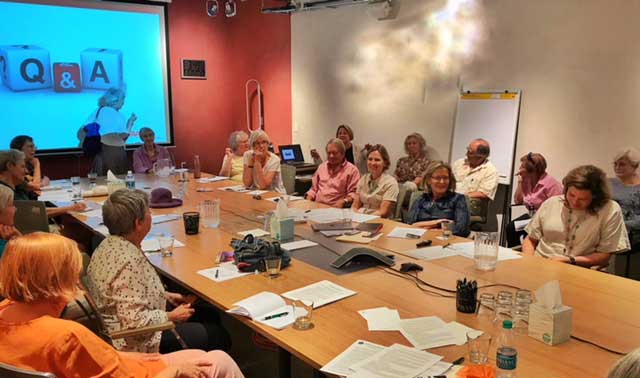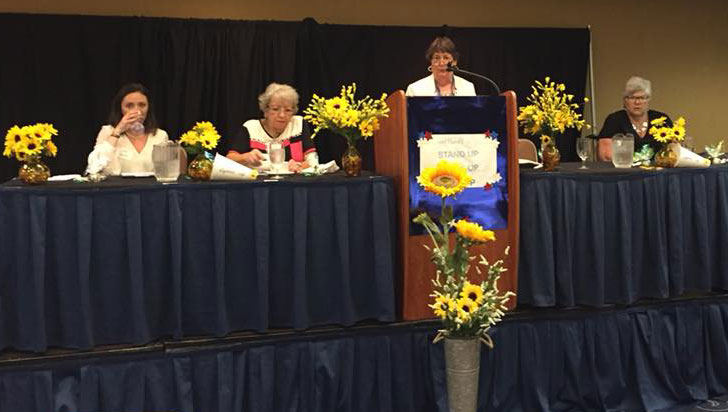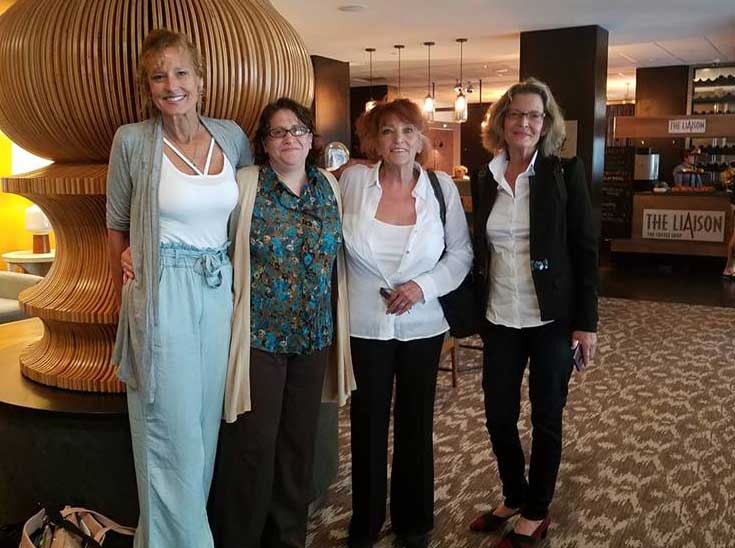Love landed Elinor Frerichs in a secured facility for people with dementia.
Twelve days after the death of her husband, 95-year-old Frerichs married a friend 26 years her junior, a man who watched the same TV shows and made her feel “happier than ever.” But shortly after saying “I do,” Frerichs was placed under a court conservatorship at the recommendation of a psychologist and Adult Protective Services. She was hospitalized and her marriage was annulled, partly to shield her estate, estimated at $1 million.
Despite concerns over her mental capacity, Frerichs appeared lucid in a transcript of a rare visit with friends, vowing, “I’m not going to sit there and rot and die in that damn room.”
PROBATE » PAGE 14
Inside: Some laws are in place to protect the elderly and the disabled PAGE A15 Inside: Questions and answers on pressing issues of probate court PAGE A15
![]()
LAURA A. ODA – BAY AREA NEWS GROUP
![]()
ABOVE: The very legal system Betty Lou Lamoreaux served as a judge is now “sucking up my aunt’s money,” says her nephew, Duff McGrath.
TOP: Kennett Taylor displays a photo of his ex-wife, Elinor Frerichs, who was put under court conservatorship and her marriage to him annulled.
COURTESY OF DUFF MCGRATH
Probate
FROM PAGE 1
She also had a few words for her conservator: “You are a bastard if I ever met one. Somehow, I’m going to get rid of you. Somehow.”
Frerichs’ case in Alameda County has caught the attention of prosecutors and reformers examining a flawed nationwide system in which strangers appointed by the court decide where people live, how their money is spent and even who they can see.
How can legal professionals have such power over the life of a noncriminal to the point that even family has no voice?
It’s called probate court, and — used properly — it can be a way to protect the elderly and disabled from physical and financial bullying by family and friends. But probate court also can open the door for high-priced professionals to swallow a client’s life savings and the family’s future inheritance.
An investigation by the Southern California News Group reveals that conservators, guardians, fiduciaries, their attorneys and judges become almost cliquish in running people’s lives.
‘Buddy-buddy system’
“Often there is a little buddy-buddy system going on: … sometimes a judge has friends who are attorneys,” said Thomas Coleman, a Palm Springs lawyer who specializes in representing the disabled.
It’s a sticky situation that can become a strain on the limited resources of the client, who is billed for the salaries and legal fees of the professionals involved in probate cases. Critics say these professionals often play one side of the family against the other.
Consider:
• In Santa Ana, courtappointed officials drained a retired judge’s savings and then forced her into a jumbo reverse mortgage on her $1.8 million house in Newport Beach to keep the money flowing.
• Again in Santa Ana, a conservator sold part of an elderly woman’s real estate to the owner of a land brokerage where he worked. The conservator then tried to collect a $9,800 commission on the sale.
• In Las Vegas, a guardian was indicted in 2017 on charges of stealing $559,205 from 150 clients from 2011 to 2016. April Parks allegedly overbilled for such things as grocery trips and making bank deposits, according to the 125-page indictment prosecuted by the Clark County district attorney’s office.
• In Berkeley, the husband of an elderly woman defied court instructions and removed his wife from what he considered to be a substandard board-andcare home where she had been placed by her conservator. The judge took no action against the husband, whose family said he could no longer sit idly by while his wife suffered.
“It’s happening again and again. It’s like a plague on our senior citizens,” said Berkeley Vice Mayor Ben Bartlett, who is among those calling for reform.
“We need to turn the operation upside down. What you see is an incentive to work up attorney fees,” Bartlett said. “There is no incentive to preserve the liberty of the person. We need greater oversight with more opportunity to challenge.”
Alameda County District Attorney Nancy O’Malley, who launched a task force to review complaints inside her county’s probate court, agrees the process may need retooling because of the expense.
“If you have 20 court appearances, it might add up,” O’Malley said. “It’s a system that needs to be evaluated, [but] we can’t shortchange protecting the senior.”
Courts jammed
Fiduciaries statewide are regulated by a small bureau that opened in 2007 after media coverage of unlicensed conservators.
The Judicial Council of California reported that probate filings reached 47,170 cases in fiscal 2015- 16. California’s Professional Fiduciaries Bureau, a division of the Department of Consumer Affairs, has one investigator and two fulltime administrators to oversee 995 licensees.
Last year, the bureau issued four citations for a total of $4,000 in penalties. One license was surrendered and three were placed on probation.
Rebecca May, chief of the bureau, did not return telephone calls seeking comment.
Amy Olson, executive director of Irvine-based Professional Fiduciary Association of California, defended her members, insisting they are genuinely concerned with the welfare of their clients.
“[They] operate under the strict rule of the court,” Olson said. “It is not as if they are going willy-nilly. Their goal is the care of the client.”
However, John Deily, an Irvine probate attorney who represents fiduciaries, says the system is fraught with conflict, in which many families don’t get along with each other or with the conservators.
“[And] our probate courts are exploding with … the volume,” Deily said. “The number of cases brought to the court is increasing.”
Against this backdrop, critics complain that some of the professionals are out to pad their own fees until the money is gone or substantially drained. They relate incidents of the elderly and disabled being isolated from their families by conservators, paying exorbitant professional fees for substandard care and seeing life savings and real estate holdings disappear while judges do nothing.
“Conservatorships are imposed [by judges] in minutes with nary a nod toward due process,” said Linda Kincaid, co-founder of the Coalition for Elder and Disability Rights, based in Northern California. “Once the conservatorship is in place, there is essentially no court oversight or accountability. Conservators and their agents are free to exploit and abuse with impunity.”
No one is immune
Betty Lou Lamoreaux was a giant on the Orange County Superior Court bench. Her work with children was so impressive that the county named the sevenstory family courthouse after her: the Lamoreaux Juvenile Justice Center.
Lamoreaux, now 94, has Alzheimer’s disease and is unable to care for herself. But she has nephews who want to help. Because of disagreements with another part of the family, they took her case to probate court, believing that a retired judge whose name adorns a courthouse would get top consideration.
Instead, nephew Duff Mc-Grath said, he has watched helplessly as no fewer than nine lawyers and a handful of contractors swallowed “Auntie Lou’s” $273,700 nest egg and forced her into a jumbo reverse mortgage. McGrath, a trustee, said he agreed to the real estate deal, but only because he believed the conservator would remove him as trustee if he didn’t agree.“If we fight it, they will fight us and use my aunt’s money to fight us,” complained Greg McGrath, Duff McGrath’s brother. “They’re just sucking up my aunt’s money.”
All this occurred under the watch of Superior Court Judge Kim Hubbard. The case has since been handed over to Judge David L. Belz.
Conservator under fire
Much of the McGraths’ criticism is aimed at Laguna Hills conservator Sally Cicerone, one of the more active conservators in Orange County. State records show she managed $26.7 million in assets in 2017.
After her first year with Lamoreaux, she billed the estate $42,210, according to records.
Among the family’s complaints: Cicerone waited four months to get a replacement for Lamoreaux’s broken wheelchair. And even then, the new chair didn’t fit and quickly broke. Cicerone billed $700 for her time.
Other documents show Cicerone billed $250 to visit Lamoreaux and take delivery of a new leather recliner in April 2017. But in a sworn declaration, Cicerone contractor Julie Sebestyen testified that it was she who visited Lamoreaux and monitored the chair delivery, not Cicerone.
Cicerone also had a system that allowed her to miss visits with Lamoreaux, but still charge for them, according to a court declaration by Sebestyen.
“On at least four different occasions, Sally told me that she deliberately did not sign in at the front desk so that no one could track her visits. By not signing in, she could allege she had visited when she had not,” Sebestyen testified. Lamoreaux has since been moved home.
“Petitioner has already demonstrated that she inflates her time and thus fee request, bills for services she has not performed, bills for services performed by others, intentionally and fraudulently falsified her time sheets … and neglected the conservatee,” the McGraths alleged in a court declaration.
Cicerone also charged for telephone calls to her attorney that did not appear on the attorney’s log of their conversations, according to allegations in court records.
Kathy Gardner, a former Cicerone employee and client, joined the chorus of people unhappy with Cicerone.
Gardner, in a court declaration, said she made bank deposits on behalf of clients, usually depositing them in batches, a process that takes about 15 minutes. Gardner said Cicerone charged for them as if they were deposited by herself, one by one, at $100 apiece. Cicerone billed Lamoreaux $2,600 to deposit her banking.
Gardner testified that Cicerone hired her at the same time that Cicerone was the conservator for Gardner’s 82-year-old father. Because of a potential conflict, Cicerone advised Gardner to use a fake name at work, said Gardner’s sworn declaration.
More allegations can be found in an appellate court ruling — Cicerone v. Kennedy — that listed overbilling in a Santa Barbara case. Justices ruled that Cicerone inappropriately paid herself $14,519 and her attorney $18,231 after they had been removed from a conservatorship case. They were ordered to return the money.
Cicerone did not return phone calls seeking comment. But in court records, Cicerone and her attorney, Neil Knuppel, denied the allegations in the Lamoreaux case, calling them “false and misleading” and made by disgruntled and spiteful former workers. They are “nothing more than an attempt to discredit … Cicerone’s character,” Knuppel wrote.
Added Cicerone: “Although there were times I did not sign in at the front desk … it was not so I could hide my visits.”
Real estate flipping
Besides the attorneys, fiduciaries and conservators, probate court also can mean a windfall for other contractors.
Joyce Marie Johnson, 74, once was a real estate broker who owned properties in the mountain town of Lytle Creek, north of Fontana, as well as in Long Beach and Seal Beach. Now she sits in an Orange County board-and-care home, dementia eating away her mind while a court conservatorship liquidates her real estate and isolates her from family members.
Like a quiet prayer, she murmurs, “Don’t forget me here.”
Johnson’s problems began after her two daughters disagreed on who should have power of attorney. The family squabble was taken to probate court and the judge appointed an attorney to represent Johnson.
After a year, Johnson’s real estate holdings were withering from a lack of attention, alleged one daughter, Purita Myers. Rents were not being collected, she said, and repairs were not being made. Long Beach fiduciary Timothy Mock was brought in by the attorney to straighten out the real estate mess. Mock, a former Torrance city councilman, is a wouldbe lawyer who failed the bar exam four times.
Mock’s answer was to sell some of the Lytle Creek properties to the owner of a real estate office where Mock worked, Long Beach Brokerage Inc. Mock sold the property to his boss for $270,000, court records say. Within days after closing escrow, Long Beach Brokerage listed the property for $570,000. The real estate was taken off the market when Myers complained.
Mock also sought $9,800 in sales commissions. And he listed his own fiduciary fees at $19,000 in the property deal.
Mock gave back the commission but remains as Johnson’s fiduciary. Under his stewardship, Johnson’s monthly expenses have climbed from $3,000 to $33,000, Myers charged in court papers.
“They don’t care about the people, they care about the money,” Myers said.
Mock defended the Lytle Creek sale, saying it was approved by a judge and that no one else would buy the property. He said he was unable to speak further because he has cancer.
The state Professional Fiduciaries Bureau investigated a complaint from Myers and found no wrongdoing on the part of Mock.
However, a June 2016 deposition of Mock was especially telling in how his clients generally fare. Mock was asked, “How do your conservatorships typically come to an end?”
He answered: “They run out of money.”
Some families are so frustrated with the probate court process that they decide to defy the court.
For years, well before Katherine Carter got sick, Credell Carter was in charge of his wife’s estate. Then, at age 84, she dissolved into dementia and stage 4 kidney failure. When Carter tried to represent his wife, an Alameda County Superior Court judge suspended him as her conservator.
Katherine Carter was placed in a home where she got substandard care, leaving the family no choice but to physically remove her, said daughter Venus Gist. They went on Valentine’s Day.“We just acted like normal. We wheeled her out, put her in the car and took her home,” Gist said. “They could have called the police, put us in jail, but they didn’t.”
No court action was taken against the family, which is trying to have Katherine Carter removed from conservatorship. In the meantime, she remains at home. Her conservator is trying to get her returned to a board-and-care.
“It’s like a circus,” Gist said of the whole ordeal. “God, please get me out of it.”
The litigation of love
Frerichs’ story reads like a movie plot: rich, elderly widow marries younger man and attempts to sign over her estate. Social service workers get suspicious that the beau has too much influence over his wealthy bride.
Kennett Taylor, the younger man in this reallife scenario, has a few other suspicions about why the probate court took control of his beloved Frerichs and her sizable estate. Taylor, 69, is African-American; Frerichs is white.
“They don’t want to see a black man end up with that amount of money,” Taylor said in a phone interview from his home in Oakland. “They’ve been running up the bills for nothing; they kidnapped her out of her house; the whole idea [for them] was to steal her estate. … They thought they could get away with it because I’m an African-American.”
Taylor said he and Frerichs had been neighbors for 10 years and compared their friendship to the one depicted in the film “Driving Miss Daisy.”
“I’m happier with you than I’ve ever been with any man. Really and truly,” Frerichs tells Taylor in the transcribed visit. “You can kiss me on the cheek.”
And so he does.
“Now,” she says, “I’m happy.”
It was Taylor who insisted Frerichs get a psychological exam to prove that she was mentally competent to include him in her will, which they believed would be contested by her stepgrandchildren.
The examiner, neuropsychologist Nancy A. Hoffman, grew concerned that Frerichs’ judgment was impaired and that she was vulnerable to financial and physical abuse by Taylor and his friends, according to her official report. Frerichs can’t see well enough to read a bill or sign a check, Hoffman noted.
She also noticed that Frerichs’ nails were chipped and she had a “slight odor,” as if she had not bathed in days. Yet, she found that Frerichs’ speech was fluent and understandable, with no evidence of impairment in expression or comprehension.
Frerichs’ marriage to Taylor in Reno, Nevada, was annulled at the behest of conservator Scott Phipps, a graduate of McCormick Theological Seminary in Chicago. Frerichs signed the annulment papers, which said: “I feel I was unable to make any sound decisions during the month that my spouse died.”
Hoffman declined to comment on the case, citing patient confidentiality. Phipps emailed a written statement: “I was appointed by the court to serve as Ms. Frerichs’ conservator and every action I have taken in that role has been done in furtherance of my duties to Ms. Frerichs and in compliance with the court’s wishes.
“As a professional fiduciary with many years of experience,” he continued, “I take my role and responsibilities very seriously and continuously work to protect Ms. Frerichs and make sure her needs are met.”
Kincaid, the activist, speculated that Frerichs didn’t understand when she signed the annulment papers.
“We also believe they told her Ken wanted the annulment,” Kincaid said. “To me, it comes down to Elinor has the right to see visitors if she wants to … [and] if she wants to give her money to a [pet] cat, she can do it. You don’t lock up little old ladies.”
Attorney Deily put it another way: “When do you lose the right to make a bad decision?”
![]()
Former Orange County Superior Court Judge Betty Lou Lamoreaux, here in 1988, had the juvenile courthouse named after her.
STAFF FILE PHOTO
![]()
Duff McGrath stands outside the Orange County courthouse named after his aunt, Judge Betty Lou Lamoreaux, whose life savings, he says, are in danger of being drained by attorneys and contractors assigned to manage her estate.
COURTESY OF DUFF MCGRATH
Full Article & Source:
‘LIKE A PLAGUE’ ON THE ELDERLY ![]()
![]()
![]()
![]()
![]()
![]()
![]()



































